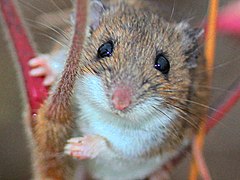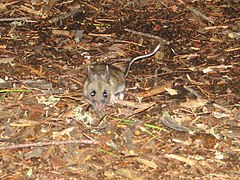White-footed mouse
| White-footed mouse | |
|---|---|

| |
| Scientific classification | |
| Kingdom: | Animalia |
| Phylum: | Chordata |
| Class: | Mammalia |
| Order: | Rodentia |
| Family: | Cricetidae |
| Subfamily: | Neotominae |
| Genus: | Peromyscus |
| Species: | P. leucopus
|
| Binomial name | |
| Peromyscus leucopus (Rafinesque, 1818)
| |

| |
The white-footed mouse (Peromyscus leucopus) is a rodent native to North America from Ontario, Quebec, Labrador, and the Maritime Provinces (excluding the island of Newfoundland) to the southwestern United States and Mexico.[1] In the Maritimes, its only location is a disjunct population in southern Nova Scotia.[2] It is also known as the woodmouse, particularly in Texas.
Description[]
Adults are 90–100 mm (3.5–3.9 in) in length, not counting the tail, which can add another 63–97 mm (2.5–3.8 in). A young adult weighs 20–30 g (0.7–1.1 oz). While their maximum lifespan is 96 months, the mean life expectancy for the species is 45.5 months for females and 47.5 for males. In northern climates, the average life expectancy is 12–24 months.[3]

Female on a staghorn sumac
Behavior and diet[]
White-footed mice are omnivorous, and eat seeds and insects. They are timid and generally avoid humans, but they occasionally take up residence in ground-floor walls of homes and apartments, where they build nests and store food.[4]
Similar species[]

This species is similar to Peromyscus maniculatus. Like the North American deer mouse, it may carry hantaviruses, which cause severe illness in humans.[5]
Connection to Lyme disease[]
It has also been found to be a competent reservoir for the Lyme disease–causing spirochete, Borrelia burgdorferi.[6]
Interactions with humans[]
The white-footed mouse is one of the most common mouse species used as laboratory mice after the house mouse, and their domesticated version is called Peromyscus leucopus linville.[7] These domesticated ones also make decent pets.[8][9] They have been bred to have many different colors.[10]
Parasites[]
The white-footed mouse is the favored host for the parasitic botfly Cuterebra fontinella.[11]
See also[]
References[]
- ^ a b Linzey, A.V.; Matson, J. & Timm, R. (2008). "Peromyscus leucopus". IUCN Red List of Threatened Species. 2008. Retrieved 5 February 2010.
- ^ Atlantic Interior, The Natural History of Nova Scotia
- ^ Mammalian models for research on aging (1981) ISBN 978-0-309-03094-6
- ^ "WHITE-FOOTED AND DEER MICE". The Internet Center for Wildlife Damage Management. Retrieved 9 June 2016.
- ^ RR5109-Front Cover-Hantavirus.p65
- ^ Donahue JG, Piesman J, Spielman A (January 1987). "Reservoir competence of white-footed mice for Lyme disease spirochetes". The American Journal of Tropical Medicine and Hygiene. 36 (1): 92–6. doi:10.4269/ajtmh.1987.36.92. PMID 3812887.
- ^ Sun Y, Desierto MJ, Ueda Y, Kajigaya S, Chen J, Young NS (2014). "Peromyscus leucopus mice: a potential animal model for haematological studies". International Journal of Experimental Pathology. 95 (5): 342–50. doi:10.1111/iep.12091. PMC 4209926. PMID 25116892.
- ^ "White-Footed & Deer Mice Care Sheet by Ann Vole".
- ^ Clive Roots; Domestication - page: 105
- ^ "Deer Mice and White-footed Mice". 2010-06-03.
- ^ Jennison CA, Rodas LR, Barrett GW (2006). "Cuterebra fontinella parasitism on Peromyscus leucopus and Ochrotomys nuttalli". Southeastern Naturalist. 5 (1): 157–168. doi:10.1656/1528-7092(2006)5[157:CFPOPL]2.0.CO;2.

Bibliography[]
- Anderson JF, Johnson RC, Magnarelli LA (1987). "Seasonal prevalence of Borrelia burgdorferi in natural populations of white-footed mice, Peromyscus leucopus". Journal of Clinical Microbiology. 25 (8): 1564–1566. doi:10.1128/JCM.25.8.1564-1566.1987. PMC 269274. PMID 3624451.
- Rogic A, Tessier N, Legendre P, Lapointe FJ, Millien V (2013). "Genetic structure of the white-footed mouse in the context of the emergence of Lyme disease in southern Québec". Ecology and Evolution. 3 (7): 2075–2088. doi:10.1002/ece3.620. PMC 3728948. PMID 23919153.
- Barthold SW, Persing DH, Armstrong AL, Peeples RA (1991). "Kinetics of Borrelia burgdorferi dissemination and evolution of disease after intradermal inoculation of mice". The American Journal of Pathology. 139 (2): 263–273. PMC 1886084. PMID 1867318.
- Bunikis J, Tsao J, Luke CJ, Luna MG, et al. (2004). "Borrelia burgdorferi infection in a natural population of Peromyscus leucopus mice: a longitudinal study in an area where Lyme borreliosis is highly endemic". The Journal of Infectious Diseases. 189 (8): 1515–1523. doi:10.1086/382594. PMID 15073690.
- Brunner JL, LoGiudice K, Ostfeld RS (2008). "Estimating reservoir competence of Borrelia burgdorferi hosts: prevalence and infectivity, sensitivity, and specificity". Journal of Medical Entomology. 45 (1): 139–147. doi:10.1603/0022-2585(2008)45[139:ercobb]2.0.co;2. PMID 18283955.
- Burgess EC, French JB Jr, Gendron-Fitzpatrick A (1990). "Systemic disease in Peromyscus leucopus associated with Borrelia burgdorferi infection". The American Journal of Tropical Medicine and Hygiene. 42 (3): 254–259. doi:10.4269/ajtmh.1990.42.254. PMID 2316794.
- Goodwin BJ, Ostfeld RS, Schauber EM (2001). "Spatiotemporal variation in a Lyme disease host and vector: black-legged ticks on white-footed mice". Vector-Borne and Zoonotic Diseases. 1 (2): 129–138. doi:10.1089/153036601316977732. PMID 12653143.
- Hofmeister EK, Ellis BA, Glass GE, Childs JE (1999). "Longitudinal study of infection with Borrelia burgdorferi in a population of Peromyscus leucopus at a Lyme disease-enzootic site in Maryland". The American Journal of Tropical Medicine and Hygiene. 60 (4): 598–609. doi:10.4269/ajtmh.1999.60.598. PMID 10348235.
- Horka H, Cerna-kyckovaa K, Kallova A, Kopecky J (2009). "Tick saliva affects both proliferation and distribution of Borrelia burgdoferi spirochetes in mouse organs an increases transmission of spirochetes by ticks". International Journal of Medical Microbiology. 299 (5): 373–380. doi:10.1016/j.ijmm.2008.10.009. PMID 19147403.
- Martin LB, Weil ZM, Kuhlman JR, Nelson RJ (2006). "Trade-offs within the immune systems of female white-footed mice, Peromyscus leucopus". Functional Ecology. 20 (4): 630–636. doi:10.1111/j.1365-2435.2006.01138.x.
- Martin LB, Weil ZM, Nelson RJ (2007). "Immune defense and reproductive pace of life in Peromyscus mice". Ecology. 88 (10): 2516–2528. doi:10.1890/07-0060.1. PMC 7204533. PMID 18027755.
- Ostfeld RS, Miller MC & Hazler KR (1996) Causes and consequences of tick (Ixodes scapularis) burdens on white-footed mice (Peromyscus leucopus). J Mammal ; 77:266–273.
- Ostfeld RS, Schauber EM, Canham CD, Keesing F & al. (2001) Effects of acorn production and mouse abundance on abundance and Borrelia burgdorferi infection prevalence of nymphal Ixodes scapularis ticks. Vector Borne Zoonot Dis ; 1:55–63
- Pederson AB, Grieves TJ (2008) The interaction of parasites and resource cause crashes in wild mouse population. J Anim Ecol ; 77:370–377
- Schwan, TG, Burgdorfer, W, Schrumpf, ME, Karstens, RH. (1988) The urinary bladder, a consistent source of Borrelia burgdorferi in experimentally infected white-footed mice ( Peromyscus leucopus). J Clin Microbiol ; 26:893–895
- Schwan TG, Kime KK, Schrumpf ME, Coe JE, et al. (1989). "Antibody response in white-footed mice (Peromyscus leucopus ) experimental infected with the Lyme disease spirochete (Borrelia burgdorferi)". Infection and Immunity. 57 (11): 3445–3451. doi:10.1128/IAI.57.11.3445-3451.1989. PMC 259851. PMID 2807530.
- Schwanz LE, Voordouw MJ, Brisson D, Ostfeld RS (2011). "Borrelia burgdorferi has minimal impact on the Lyme disease reservoir host Peromyscus leucopus" (PDF). Vector-Borne and Zoonotic Diseases. 11 (2): 117–124. doi:10.1089/vbz.2009.0215. PMID 20569016.
External links[]
- White-footed Mouse, State University of New York, College of Environmental Science and Forestry
- White-footed Mouse, CanadianFauna.com
- White-footed Mouse, Canadian Biodiversity Website
- . Encyclopedia Americana. 1920.
- IUCN Red List least concern species
- Mammals described in 1818
- Peromyscus
- Taxa named by Constantine Samuel Rafinesque


